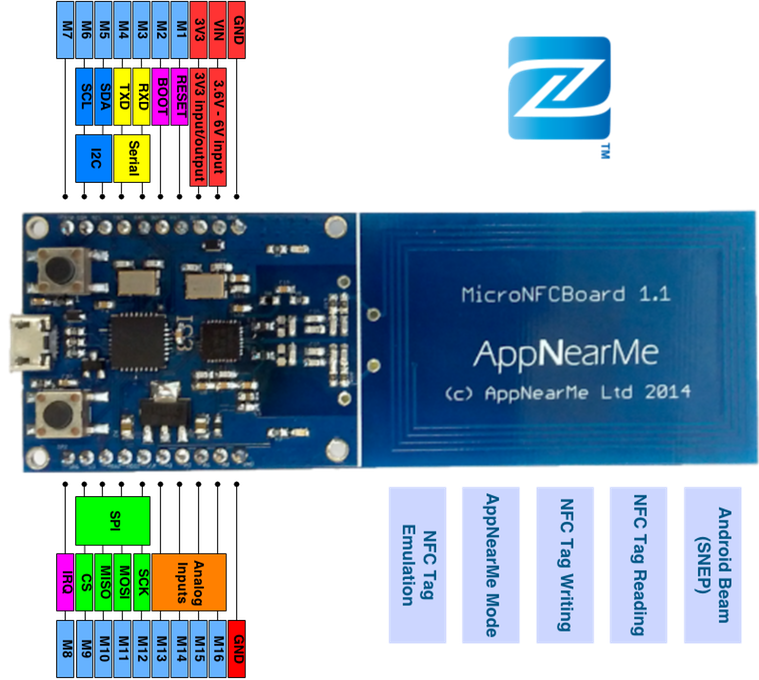PolyMCU is an open-source framework for micro-controller. The framework is only based on existing and mature open-source components.
- Clone the Github repository
git clone https://github.com/labapart/polymcu.git
cd polymcu
- Set
CROSS_COMPILEenvironment variable with your ARM GNU Toolchain. Example:
export CROSS_COMPILE=~/Toolchains/gcc-arm-none-eabi-4_9-2014q4/bin/arm-none-eabi-
- Create the build directory
mkdir Build && cd Build
- Build the firmware
cmake -DBOARD=AppNearMe/MicroNFCBoard -DAPPLICATION=Examples/Baremetal ..
make
- If the MicroNFCBoard is into the built-in USB programming mode (ie: the board appears as
CRP DISABLDon your host machine) then you can install the newly build firmware with:
make install
- Install CMake: https://cmake.org/download/
- Install the latest GCC v4.9 2015q3 for ARM Cortex M: https://launchpad.net/gcc-arm-embedded/4.9/4.9-2015-q3-update/+download/gcc-arm-none-eabi-4_9-2015q3-20150921-win32.zip
- Install MinGW: https://sourceforge.net/projects/mingw/files/Installer/mingw-get-setup.exe/download (mingw32-base, mingw32-gcc-g++)
-
Download the latest sources of PolyMCU at https://github.com/labapart/polymcu/archive/master.zip
-
Un-archive
master.zip -
Start a command line shell (ie:
cmd.exe) -
Add CMake and MinGW to your
PATHif it is not already done. For instance:
SET PATH="c:\Program Files (x86)\CMake\bin";%PATH%
SET PATH=C:\MinGW\bin;%PATH%
- Add your toolchain into the
CROSS_COMPILE. For instance:
SET CROSS_COMPILE=c:\Users\Olivier\gcc-arm-none-eabi-4_9-2015q3-20150921-win32\bin\arm-none-eabi-
- Create the
Builddirectory into PolyMCU root
cd <PolyMCU Root>
mkdir Build
cd Build
- [Optional] To build with LLVM
set PATH="C:\Program Files (x86)\LLVM\bin";%PATH%
set CC=clang.exe
- Build the project
cmake -G "MinGW Makefiles" -DAPPLICATION=Examples/Baremetal -DBOARD=AppNearMe/MicroNFCBoard ..
mingw32-make
- hold the Bootloader button (right button)
- while pressing the Bootloader button press the Reset button (left button) and then release it.
- release the Bootloader button
The board should appear as an USB mass storage device with the label CRP DISABLD.
- Download the driver at https://dev.appnearme.com/static/micronfcboard/drivers/micronfcboard_serial.inf
- Plug the MicroNFCBoard to your Windows host machine. Windows will try to find an existing driver for it without success
- Open the Windows Device Manager to find the non recognized device
- Right click on the device >
- Update driver software
- Click on "Browse my computer for driver software"
- Indicate the path where you downloaded micronfcboard_serial.inf
- Accept the warning message
The board uses NXP LPC11U34FHN33/421 (ARM Cortex-M0).
| AppNearMe Diagram Label | Board Label | NXP LPC11U3x label |
|---|---|---|
| M9/CS | CS | PIO0_2/SSEL0 |
| M10/MISO | MISO | PIO0_8/MISO0 |
| M11/MOSI | MOSI | PIO0_9/MOSI0 |
| M12/SCK | SCK | SWCLK/PIO0_10/SCK0 |
| M15 | A1 | SWDIO/PIO0_15/AD4 |
-
LPC_SSP0is exposed to the MicroNFCBoard pin 9-12. -
LPC_SSP1is connected to NXP PN512. -
GPIO@M9 (SPI_CS) is PIO0_2.
-
SWD Debug pins:
SWCLKpin M12SWDIOpin M15
To redirect printf output through the UART/Serial port instead of using UART-over-USB rebuild your application
with the CMake parameters -DSUPPORT_DEBUG_UART=uart -DDEBUG_UART_BAUDRATE=9600 (eg: use a baudrate of 9600).
| SWD pin | Mbed pin | AppNearMe pin |
|---|---|---|
| SWCLK | pin15 | M12 |
| SWDIO | pin16 | M15 |
| nRESET | pin17 | M1 |
MicroNFCBoard SWDIO and SWDCLK pins are on function 0. So, there is no need to change pin mapping.
- CMSIS RTOS example does not work (yet) on the board
